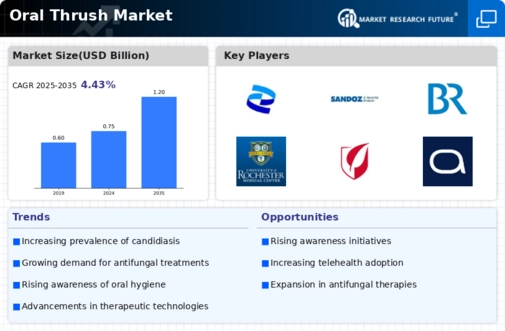Oral Thrush Market Summary
As per Market Research Future analysis, the Oral Thrush Market was valued at 0.75 USD Billion in 2024 and is projected to grow to 1.2 USD Billion by 2035, with a CAGR of 4.43% from 2025 to 2035. The market is driven by the increasing prevalence of oral thrush among immunocompromised individuals, rising awareness of oral health, and advancements in antifungal treatments. The demand for effective therapies is further supported by the growing incidence of diabetes and the emergence of innovative treatment options.
Key Market Trends & Highlights
Key trends driving the Oral Thrush Market include advancements in treatment options and increased awareness.
- The market is expected to reach 0.75 USD Billion in 2024, with antifungal medications holding a significant share valued at 0.3 USD Billion.
- The elderly and immunocompromised populations are key demographics, with rising cases of diabetes contributing to market growth.
- North America is projected to lead the market with a valuation of 0.3 USD Billion in 2024, growing to 0.5 USD Billion by 2035.
- Innovative antifungal treatments are being developed to combat resistant strains, enhancing market dynamics.
Market Size & Forecast
| 2023 Market Size | USD 0.71 Billion |
| 2024 Market Size | USD 0.75 Billion |
| 2035 Market Size | USD 1.2 Billion |
| CAGR (2025-2035) | 4.43% |
Major Players
Key players include Pfizer, Sandoz, Bayer, Roche, Gilead Sciences, AbbVie, Johnson and Johnson, Eli Lilly, Novartis, Mylan, Astellas Pharma, Bristol-Myers Squibb, Merck, and Amgen.

























Leave a Comment